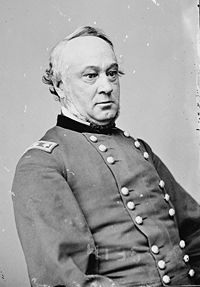
The main area of contention of the Battle of Brandy Station was Fleetwood Hill where Stuart was placed during the reviews. Pleasonton later felt that their presence was known and actions anticipated due to the splashing of Buford’s men around 4:00 a.m. and fearing that they would be pushed back because of heavy losses sent a message to Hooker. “12:30 p.m.(received 3:20 p.m.) General Gregg has joined me, and I will not attack the enemy vigorously with my whole force…I would be well to send a good force of the Fifth corps toward Brandy Station, if it can be spared.”[5] This battle is considered the largest cavalry battle during the whole war and through a day of fighting, Stuart pulled back and cancelled any raid that he planned to make. “We captured Stuart’s camp, with his orders, letters, &c. He was to move to Maryland with 12,000 cavalry and twenty-five guns, and he was camped at the ford we crossed…The enemy lost very heavily.”[6] And from this point forward, the cavalry of the Army of the Potomac would not be underestimated.
Upon reports to Washington about the attack at Brandy Station, most of the praise went to Pleasonton but all that was shown was a lack of interest from Halleck. And upon sending an uproarious report praising the cavalry, it seemed as though both Lincoln and Halleck seemed to ignore the engagement. “I dispatched General Pleasonton to attack him on his own ground…This, in the face of vastly superior numbers, was only accomplished by hard and desperate fighting by our cavalry, for which they deserve much credit. Their morale is splendid. They made many hand-to-hand combats, always driving the enemy before them.”[7] The reports sent back to him later on in the day not only ignored what was sent earlier that day, but accosted Hooker for not moving fast enough against an enemy that has crossed the Rappahannock River. Small bits of information started to pour in on the enemy found in small forces all around the north of Virginia especially Winchester. A correspondence from Lincoln questioned whether or not Hooker’s reconnaissance found anything in or around the vicinity of that city. “Do you consider it possible that 15,000 of Ewell’s men can now be at Winchester?”[8] Hooker’s reaction to the many reports coming in about enemy movement was as professional as he could be. Researching them himself he discovered something that the President and his staff may not have considered. “Hooker pointed out to Lincoln that his information service was not equipped to cover country as far afield as that where the enemy was operating.”[9] Hooker was attaining information as best as he could at the time, especially for the man who had created such a great system of internal information during the war. Through a strict communication between his own corps and division commanders, he found many positions of the Confederate army and the movements they were making. “Major General Hancock reports that the rebel forces about Fredericksburg have moved in the direction of Culpepper this morning.”[10] He also, in the most professional sense, keeps the high command informed about his own movements and in that same report also states where the moving parts of the army had gone to. At Fairfax Station, Hooker will follow the movements of the enemy closely along with corresponding with information that the high command receives. Every day, he reports his movements and information to the President and sometimes General Halleck as he would be expected to do. However, the lack of reports to the General-in-Chief only fueled some of the anger between the two as Hooker only reports to Lincoln.
[1] Kunstler, Mort. “The Civil War Paintings of Mort Kunstler Volume II: Fredericksburg to Gettysburg.” Pg. 215.
[2] Burke, Davis. “JEB Stuart, The Last Cavalier.” Pg. 304.
[3] Ibid, Pg. 305.
[4] Ibid, Pg. 305.
[5] Official Records of the War of the Rebellion Union and Confederate Armies Series I, Volume 27, Part 1. Pg. 903.
[6] Ibid, Pg. 904.
[7] Ibid. Pg. 36.
[8][8] Ibd, Pg. 38.
[9] Fischel, Edwin C. “The Secret War for the Union: The Untold Story of Military Intelligence in the Civil War.” Pg. 456.
[10] Official Records of the War of the Rebellion Union and Confederate Armies Series I, Volume 27, Part 1. Pg. 41
 RSS Feed
RSS Feed
